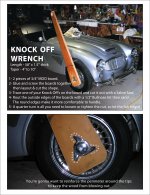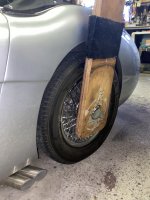petnatcar
Senior Member
Offline
Hi Guys,
Who likes to "beat the livin' crap out of their Knock Off Hubs" ? Raise your hand.
Just the thought of removing a Knock Off was stressful enough for me, especially when they're new !
Obviously this "wrench" is only for the garage but it works flawlessly.
One quarter turn is all you need to tighten or remove the Knock Off.
The section of black carpet was added to protect the paint from scratches.
I still keep a 5# Sledge hammer and a piece of hardwood in the trunk but only for self defense.
Bouna fortuna,
Peter C.
Who likes to "beat the livin' crap out of their Knock Off Hubs" ? Raise your hand.
Just the thought of removing a Knock Off was stressful enough for me, especially when they're new !
Obviously this "wrench" is only for the garage but it works flawlessly.
One quarter turn is all you need to tighten or remove the Knock Off.
The section of black carpet was added to protect the paint from scratches.
I still keep a 5# Sledge hammer and a piece of hardwood in the trunk but only for self defense.
Bouna fortuna,
Peter C.

 Hi Guest!
Hi Guest!

 smilie in place of the real @
smilie in place of the real @
 Pretty Please - add it to our Events forum(s) and add to the calendar! >>
Pretty Please - add it to our Events forum(s) and add to the calendar! >> 


